2020 has been a great year for stargazers, if not for much else. It will come to an impressive close with a rare “Great Conjunction” of the planets Jupiter and Saturn in our night sky, visible to almost everyone on our troubled planet Earth.
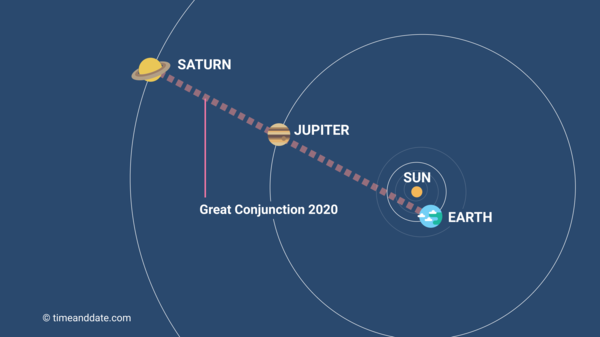 View of the Great Conjunction, as seen from above the plane of the solar system. The planets revolve counter clockwise around the Sun, while Earth rotates clockwise on its axis. Jupiter will be 556 million and Saturn 1.024 billion miles from Earth on December 21, so this image, from timeanddate.com, is not to scale.
View of the Great Conjunction, as seen from above the plane of the solar system. The planets revolve counter clockwise around the Sun, while Earth rotates clockwise on its axis. Jupiter will be 556 million and Saturn 1.024 billion miles from Earth on December 21, so this image, from timeanddate.com, is not to scale.As can be seen in the image, Saturn, Jupiter, and the Earth will all fall into line, most nearly a straight line on December 21. The rarity of the event is caused by several factors, the most important being that Jupiter takes nearly twelve years to revolve around the Sun one time, while Saturn takes nearly thirty years. If you do the math, this means that Jupiter appears to pass Saturn in our skies just under every twenty years, an event called a Great Conjunction. However, not all of these are created equal. The orbits of Earth, Jupiter, and Saturn are nearly but not exactly in the same plane, and this can cause differences in how close together the two outer planets can appear. In addition, their orbits are slightly out of round, so that sometimes they are slightly nearer or farther away than they might be otherwise. If you put all these together, it turns out that the December 21 grouping will be the closest that Jupiter and Saturn have appeared together since 1623, when telescopes were a brand new invention.
Unfortunately, there is a bit of a fly in the ointment to this December’s event. You can see from the image above that it will be not just the planets that are lined up, but that the Sun will be almost in the line too. Fortunately, it won’t be exactly in line, or we couldn’t see the Great Conjunction at all! Earth rotates clockwise, so that Jupiter and Saturn will closely follow the Sun in the sky, appearing low in the southwestern sky as it gets dark, and setting just a couple of hours after sunset. To see this rare event, it will be essential to find a spot that has an open view to the southwest, and look early fpr the best view, around 5:30 or 6 pm. It is also clear from the image above that since Jupiter and Saturn will be on the far side of the Sun from Earth, and thus will appear a bit dimmer and smaller than usual. Although far away, they are the two largest planets and reflect the Sun’s light well. Distant Saturn is a match for the brighter stars in the night sky, while Jupiter outshines all stars. There should be no trouble in spotting them if you have a decently clear sky and the needed southwest horizon.
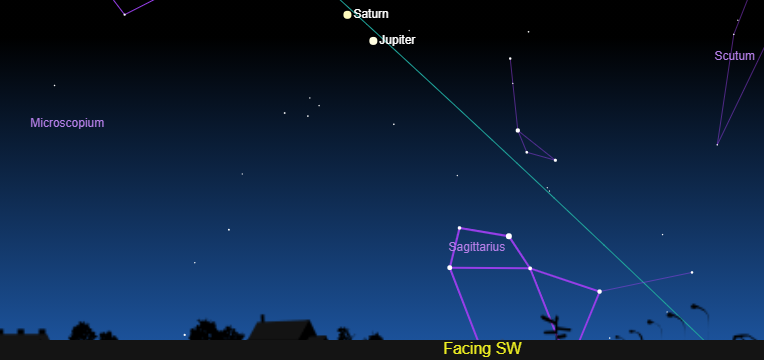
In this view above, set for December 1, about 5:45 pm St. Louis time, Jupiter and Saturn will appear 2.2 degrees apart, easily in the same binocular field of view. Earth’s revolution around the Sun will cause the background stars to sink towards the horizon as the weeks pass. Jupiter and Saturn will also sink, but not as quickly due to their own motion around the Sun. Image from Sky & Telescope.
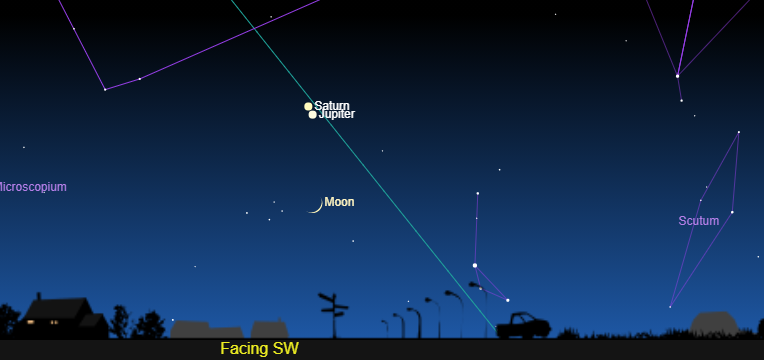
About two weeks later, on December 16, also shown for 5:45 pm, the gap between Jupiter and Saturn will have narrowed to 0.6 degrees, or just slightly larger than the apparent size of the Moon. On the night of the 17th, the crescent moon, due to its revolution around the Earth, will appear to the upper left of the Jupiter-Saturn pair. On either night, try taking a photo with a camera on a tripod and a short time exposure. You may record earthshine, the outline of the unlit part of the crescent moon, faintly lit up by sunlight reflecting off the Earth, on to the Moon, and then back again. The image is courtesy of Sky & Telescope, and the Moon is shown much bigger than scale so that the phase can be seen.
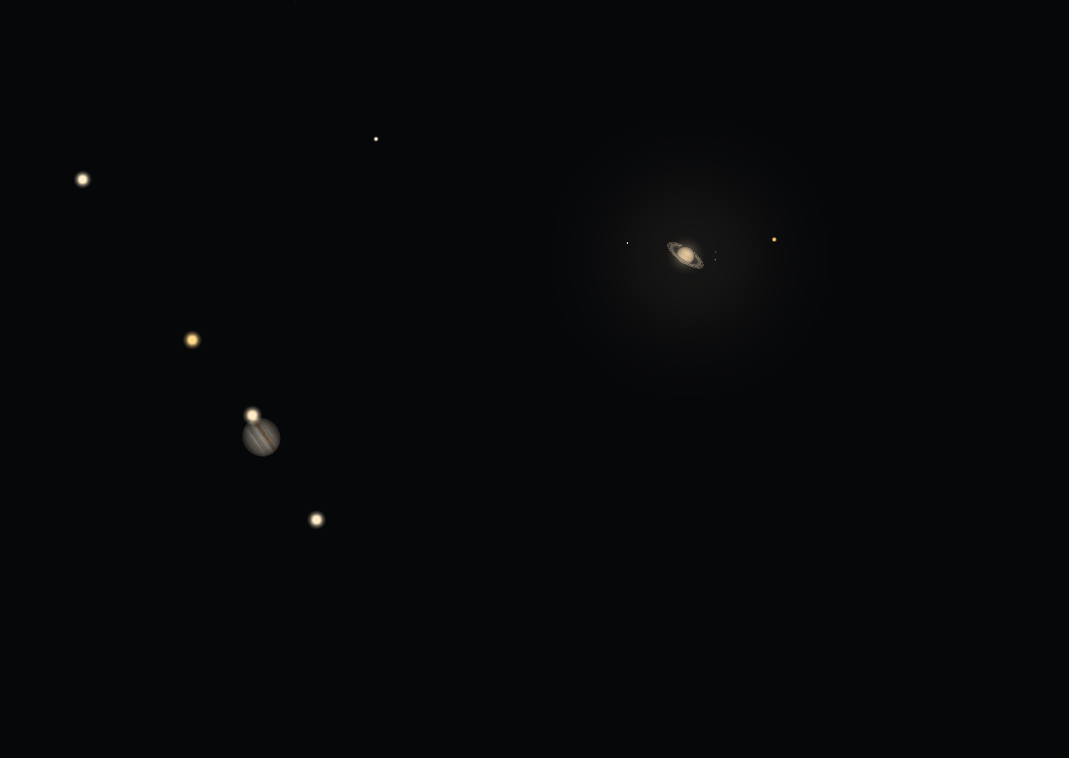
On December 21, the date of closest approach, Jupiter and Saturn will appear just 1/10 of a degree apart, or one fifth the size of the full moon in the sky!! It may be hard to tell them apart with the unaided eye, so bring binoculars or a telescope if you have them. Don’t miss this rare but easy to see spectacle- if the weather is bad, the difference 1-2 days on either side will be slight. Due to their low altitude in the sky, Jupiter and Saturn may appear rather shaky and blurry as seen in a telescope, but they can be seen together in the same low to medium power field of view for a few nights around the 21st. Through a decent telescope, up to four of Jupiter’s largest moons may be seen flanking the planet. Depending upon the steadiness of the atmosphere, cloud bands might be seen on Jupiter, along with Saturn’s rings, as shown in this Stellarium simulation.
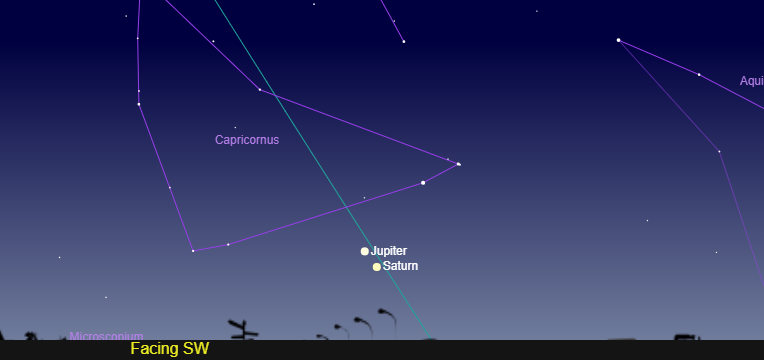
By December 31, also shown for 5:45 pm St. Louis time, the two planets will have switched places, with Saturn now appearing to the lower right. By now, they have sunk quite low in the sky as they appear more and more in the same direction as the Sun. Both will be lost in the glow of sunset by the end of the first or second week of January. Bring binoculars to follow them for a few days longer, and to show Mercury near Jupiter and Saturn from January 9-12, forming a short-lived trio. Jupiter and Saturn will emerge into the predawn sky in late winter, still fairly close together, and we can witness the pair gradually separate all through 2021 and the years that follow.
A typical Great Conjunction has a Jupiter-Saturn separation of 1-2 degrees in the sky. I remember the 1981 event, which occurred while I was in college, very well, and of course also the one in 2001. The next two, in 2040 and 2060, will be similar. How old will you be then? All Great Conjunctions are impressive, but that of 2020 is in a class almost by itself, ten times or more closer than the others I just described. Looking way ahead, mark your calendar for the morning of March 15, 2080, when in a near-replay of this year, Jupiter and Saturn will once again be 1/10 degree apart, but in the predawn sky. I don’t think my alarm clock will wake me, but will any of my younger readers get to see it?
The Gateway to the Stars program is complete for 2020. We plan to resume in May 2021 with a schedule of astronomy education programs and telescope viewing. Depending upon the state of the pandemic, these programs may be presented virtually or in person.
